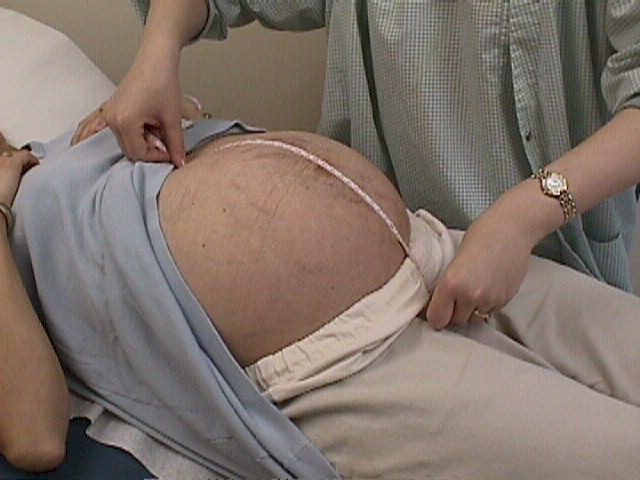|
Diagnosis of Pregnancy
Pregnancy may be suspected
in any sexually active woman, of childbearing age, whose menstrual
period is delayed, particularly if combined with symptoms of early
pregnancy, such as:
-
Nausea (1st trimester)
-
Breast and nipple tenderness (1st trimester)
-
Marked fatigue (1st and 3rd trimesters)
-
Urinary frequency (1st and 3rd trimesters)
-
The patient thinks she's pregnant
Early signs of pregnancy may include:
-
Blue discoloration of the cervix and vagina (Chadwick's sign)
-
Softening of the cervix (Goodell's sign)
-
Softening of the uterus (Ladin's sign and Hegar's sign)
-
Darkening of the nipples
-
Unexplained pelvic or abdominal mass
|
 Pregnancy Tests
The diagnosis of pregnancy is accurately made with a urine
pregnancy test. Current test kits are highly specific and detect 35-30
mIU of HCG (human chorionic gonadotropin, the pregnancy hormone) per
ml of urine. In other words, the pregnancy test will be turning from
negative to positive at about the time of the first missed menstrual
period.
In the event of an "equivocal" pregnancy test...one that is not
really positive nor negative, additional urine can be put through the
test kit to boost the sensitivity. Instead of using 3 drops of urine,
you can use up to 6 drops of urine. This will virtually double the
sensitivity of the test, while increasing the chance of a false
positive by only a small amount.
In an urgent situation, if a patient is unable to provide urine for
the test, serum can be used in the urine test kit in place of urine.
-
Draw blood into a test tube.
-
Tape the test tube to the wall for about 10 minutes (allow it to
clot).
-
Using an eye dropper or a syringe with a needle, draw off a
small amount of serum (the clear, watery part of the blood that's
left at the top of the test tube after the blood has clotted).
-
Use the serum instead of urine in the urine pregnancy test kit,
drop for drop. If the test kit calls for 4 drops of urine, use 4
drops of serum.
This is an imperfect solution, because the forms of HCG (pregnancy
hormone) found in serum are somewhat different from the forms found in
urine. Further, the serum proteins tend to sludge up the test kit,
both mechanically and biochemically. That said, using serum instead of
urine will work well enough for most purposes in an operational
setting and can provide immediate insight into the patient's problem.
Prenatal Care
At the first prenatal visit, take a careful history,
looking for factors that might increase the risk for the pregnant
woman. Many providers use a questionnaire, filled out by the patient,
as a starting point for this evaluation. A sample Prenatal
Registration and Obstetrical Questionnaire form can be used for this
purpose.
One important aspect of prenatal care is education of
the pregnant woman about her pregnancy, danger signs, things she
should do and things she should not do. Many providers find it useful
to give the woman printed material covering these issues that she can
take with her. This allows her to read the material at a later time
and to refer to it whenever she has questions. A sample Prenatal
Information form can be printed and used.
Routine visits:
-
every 4 weeks until 28 weeks' gestation
-
every 2-3 weeks until 36 weeks' gestation
-
every week from 36 weeks to delivery
Continue
to the PowerPoint Lecture... |


